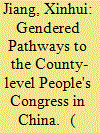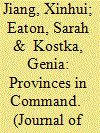| Srl | Item |
| 1 |
ID:
184719


|
|
|
|
|
| Summary/Abstract |
Women are underrepresented in legislature almost worldwide, and China is no exception. Although the Chinese Communist Party (CCP) implemented its first gender quota in 1933, gender quotas and women's representation in China remain understudied. This study fills the literature gap by examining the subnational variation in gender quota implementation and women's representation in the county-level people's congresses (CPC). Through a comparison of four county-level units in Hunan and Hubei with similar socioeconomic features yet contrasting results in the numbers of female representatives elected in the 2016 CPC election, this study argues that women's access to CPCs is affected by the CCP's adoption and enforcement of grassroots quotas. The fieldwork shows that although all cases introduced a 30 per cent gender quota, only CPCs in Hunan province were able to meet the quota requirements. This was because the grassroots quota threshold was raised in Hunan and strictly enforced, partly as a response to the 2013 Hengyang vote-buying scandal. In contrast, CPCs in Hubei province nominated a large number of “first hands” (yibashou) candidates, very few of whom were women.
|
|
|
|
|
|
|
|
|
|
|
|
|
|
|
|
| 2 |
ID:
192132


|
|
|
|
|
| Summary/Abstract |
China’s ‘Xi-Li era’ is said to be defined by both the concentration of power in the center and the strengthening of Party authority. In this paper, we ask whether these trends have been evident in local appointment practices since Xi Jinping took office in 2013. By comparing the career histories of 3,682 prefectural mayors and Party Secretaries under the Hu-Wen and Xi-Li administrations, we find that while appointment practices have shifted, the observed changes are not wholly consistent with the center- and Party-strengthening narratives. First, developments in the Xi-Li era suggest that while provincial authorities are increasingly using prefectural appointments for their own ends, the center remains high and far away in these decisions. Second, we do not find evidence that cadres with a strong Party background have a particular advantage in the Xi period. Instead, cadres with strong track records in key functional xitong, particularly those with an economic profile, are still the most likely to attain leadership positions. These findings contribute to the current debate on the nature of power reconfigurations unfolding in Xi’s China.
|
|
|
|
|
|
|
|
|
|
|
|
|
|
|
|